Sam Hing Ho Shop - business of Lum May & Tak Num
Introduction
Text-to-speech Audio
Images
Chinese Stores north of 9th St
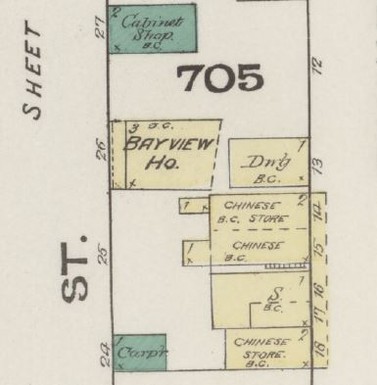
Lum May Affidavit - page 1
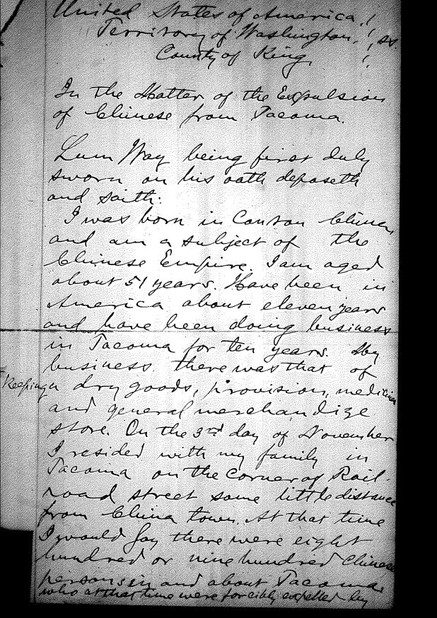
Transcription of Lum May Affidavit
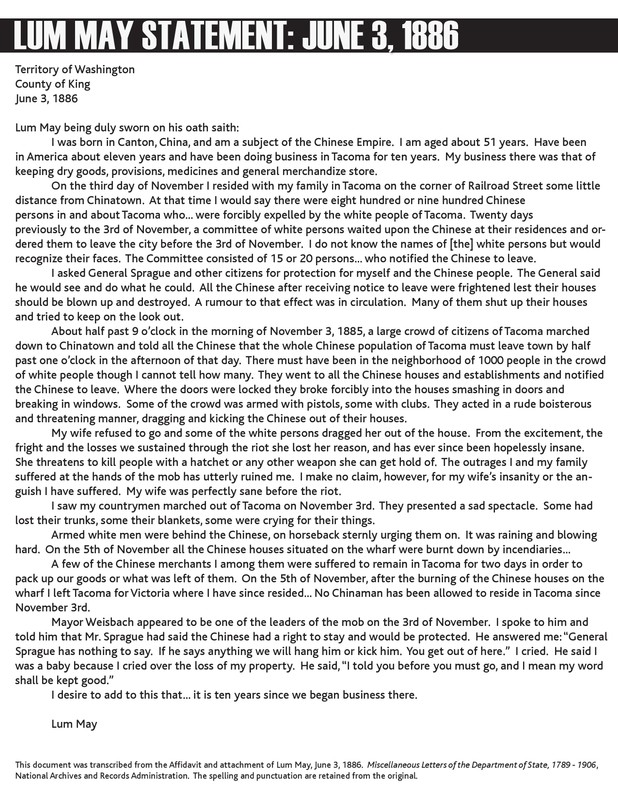
Tak Nam Affidavit - page 1
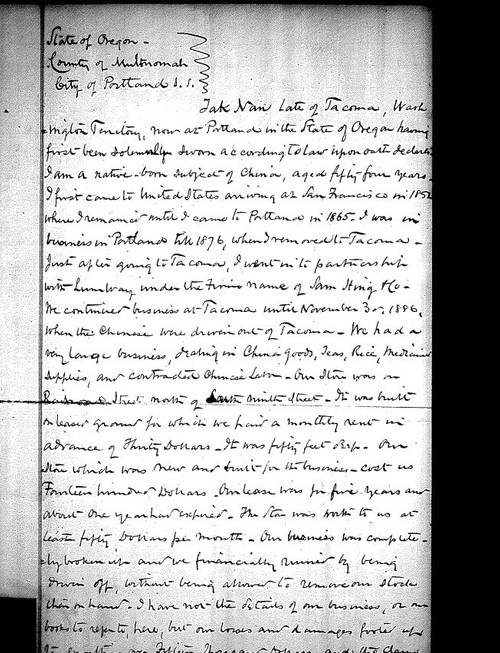
List of Chinese businesses destroyed by rioters - page 1
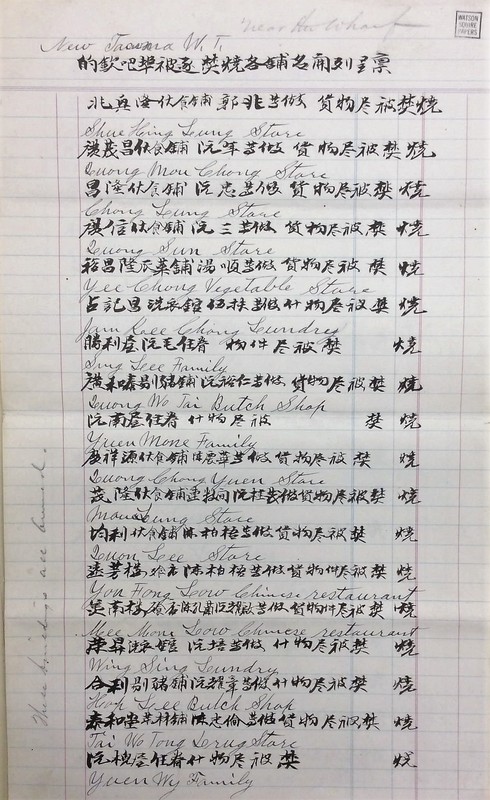
List of Chinese businesses destroyed by rioters - page 2
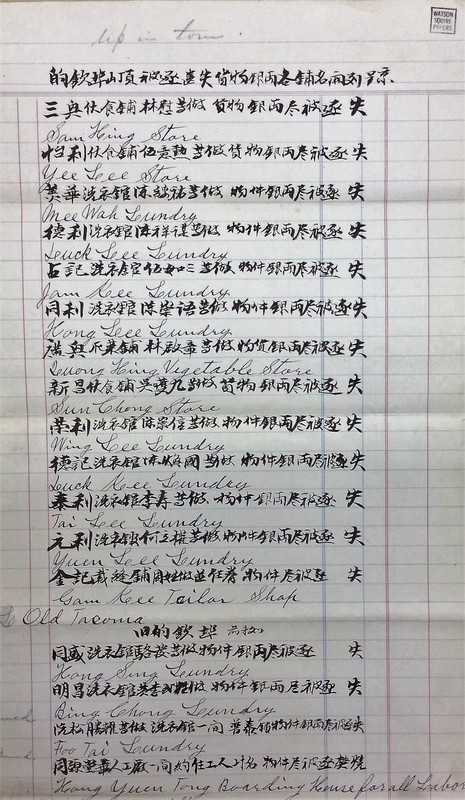
Backstory and Context
Text-to-speech Audio
According to Sanborn Insurance Maps from 1885, Commerce Street as we call it today was then known as Railroad Avenue (south of 9th Street) and Rainier Avenue (north of 9th Street). In the affidavits of Lum May and Tak Nam, they wrote about the business they owned there which they lost due to the expulsion.
From Tak Nam's affidavit:
"We had a very large business, dealing in China goods, Teas, Rice, Medicinal supplies, and contracted Chinese Labor. Our store was on Railroad street north of south ninth street. "
This location can be seen in the 1885 Sanborn Insurance Map. The business that was owned by Lum May and Tak Nam was located approximately where the Winthrop Apartments (formerly the Winthrop Hotel) now stands.
This was a new building for the store, the proprietors had built it the year before. The business itself was not new, having started around 1876. As you step through the front doors into the long building you smell the pungent scents of the tea, spices, and medicines sold there. The large business was run by partners Tak Nam and Lum May. In addition to the tea, spices, and medicine, the store also sold dry goods, provisions, and general merchandise. They also contracted Chinese labor.
A few weeks prior to November 3rd, the Committee of Fifteen, a group of 15 unelected white men appointed to take charge of the forced removal of the Chinese, went from house to house ordering all the Chinese to leave town before November 1st. After the Chinese were ordered to leave town, they were afraid, and many rumors circulated as to what would happen. In Lum May’s affidavit he says, “I asked General Sprague and other citizens of Tacoma for protection for myself and the Chinese people. The general said he would see and do what he could.” No help came for the Chinese residents.
Tak Nam describes the events of the forced removal in his affidavit. He says:
“In the morning of the 3rd of November, 1885, a crowd of several hundred white persons came to our store and broke open the door and many of them ushered in. I remember Jacob Ralph being inside. They were angry and excited. They roughly caught hold of one or two Chinamen and shoved them out the door on to the street…In the crowd of those I knew, I saw Mayor Weisbach, Sheriff Byrd, Mr. Jacob Ralph, there were a good many faces I knew, but I did not know the names…About 2 o’clock the crowd came back with wagons. I was driven from my store and home along with other Chinamen. Those who held back were pushed along. The crowd who drove us out numbered several hundred. Some had clubs, some had poles and they used these to drive us like so many hogs, if any us had slowed or stopped. I saw several guns among the crowd – some exhibited pistols, others had clubs or big sticks. I was very much afraid. We were obliged to walk out to Lake View Station on the Railroad where we stayed all night in a drenching rain without any shelter. The next morning I went on the train to Portland. There were about one hundred who had enough money to get to Portland on the train. The rest started walking to Portland. There were two Chinamen died from exposure of the crowd driven away from Tacoma, before reaching Portland. One of them was named, the other man, I do not remember the name of.”
Lum May describes the forced removal by saying,
“About half past 9 o’clock in the morning of November 3, 1885 a large crowd of citizens of Tacoma marched down to Chinatown and told all the Chinese that the whole Chinese population of Tacoma must leave town…They went to all the Chinese houses and establishments and notified the Chinese to leave. Where the doors were locked they broke forcibly into the houses, smashing in doors and breaking in windows. Some of the crowd were armed with pistols, some with clubs. They acted in a rude boisterous and threatening manner, dragging and kicking the Chinese out of their houses. My wife refused to go, and some of the white persons dragged her out of the house. From the excitement, the fright and the losses we sustained through the riot she lost her reason, and has ever since been hopelessly insane…The outrages I and my family suffered at the hands of the mob has utterly ruined me…A few of the Chinese merchants, I among them were suffered to remain in Tacoma for two days in order to pack up our goods or what was left of them. On the 5th of November, after the burning of the Chinese houses on the wharf I left Tacoma.”
Lum May returned to Tacoma in April of 1886. He needed to get a letter from Mayor Weisbach to ensure his safety during the visit.
Sources
- Affidavit of Lum May, May 2, 1886, Miscellaneous Letters of the Department of State, 1789-1906, NARA, M-179, Roll 707
- May, Lum. “Affidavit in the Matter of the Expulsion of the Chinese from Tacoma.” Watson Squire to Thomas Bayard and Secretary of the Interior, July 17, 1886. Miscellaneous Letters of the Department of State, 1789-1906, M179, roll 707. General Records of the Department of State. RG59. National Archives and Records Administration, Washington, DC.
- Affidavit of Tak Nam, June 15, 1886, Miscellaneous Letters of the Department of State, 1789-1906, NARA, M-179, Roll 707.
- Nam, Tak. “Affidavit in the Matter of the Expulsion of the Chinese from Tacoma.” Watson Squire to Thomas Bayard and Secretary of the Interior, July 17, 1886. Miscellaneous Letters of the Department of State, 1789-1906, M179, roll 707. General Records of the Department of State. RG59. National Archives and Records Administration, Washington, DC.
Sanborn Insurance Map (1885)
Washington State Historical Society
Univ. of Washington Archives
Univ. of Washington Archives
